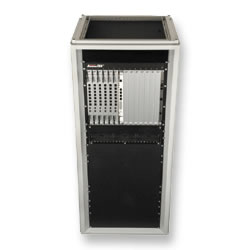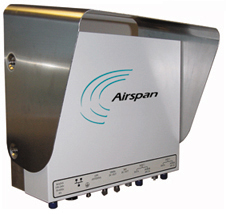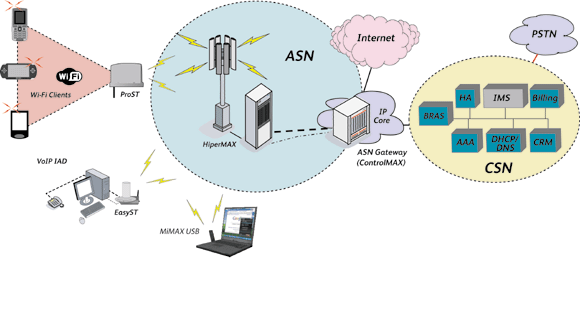+7 (812) 929-8283
Airspan HiperMAX
Особенности

HiperMAX ltimate Mobile WiMAX base station designed for high-density deployment situations. HiperMAX has been architected to provide a highly scalable, fully redundant base station product that will continue to deliver the optimum performance for years to come.
HiperMAX is fully compatible with the Mobile WiMAX Network Reference Model (NRM) as part of the Access Service Network (ASN). HiperMAX supports the reference point (R6) between the base station and the ASN Gateway as well as the reference point (R8) between base stations. HiperMAX interworks with Airspan’s ASN Gateway called ControlMAX and with other third party ASN gateways.
HiperMAX represents the state of the art, next generation base station design and includes:
- Fully upgradeable, software defined, PHY and MAC layers enabling simultaneous support for both Mobile WiMAX (SOFDMA) and Fixed WiMAX (OFDM)
- Fully digital, OBSAI based, fibre optic interfaces between indoor and outdoor equipment, which can operate at up to 3km.
- Multi-channel transmit and receive diversity
- 2x2 and 4x2 MIMO configurations
- 4 or 8 channel Smart Antenna Systems (SAS)
- Support for FDD and TDD profiles HiperMAX is designed to deliver the best link budget with the highest capacity and net throughput; all essential qualities for macro-cell deployments used in typical wireless roll out.
HiperMAX implements an all-outdoor radio with up to eight-element antenna array system. All HiperMAX base stations support SAS and multi-channel Transmit and Receive diversity and are platform ready for SDMA, which uses the antenna array to enhance capacity and improve frequency re-use.
HiperMAX base stations cooperate with the IMS which is part of the Connectivity Service network (CSN) to deliver voice and other multimedia services and can also be configured to support VoIP applications, using a standard media gateway to the PSTN.
HiperMAX Operation
The flexibility of the HiperMAX architecture allows many deployment configurations including those suited to both macro and micro cellular installations. It supports all outdoor as well as split indoor / outdoor configurations allowing the operator to select the deployment model best suited to operational expense considerations and site access constraints.
A HiperMAX Base station configured for traditional multi-sector macro-cell deployments consists of a baseband section, suitable for location within a protected environment, and an outdoor RF section. The indoor boards, referred to as blades within the ATCA standard, are housed in a 5 or 14 slot NEBS compliant ATCA chassis. The outdoor enclosure contains the RF subsystem components, which enables smart antenna functionality running on a Software Defined Radio (SDR). The connection between the baseband and RF sections is made through a fibre optic cable.
HiperMAX supports different antenna options including:
- Tx and Rx Diversity
- 2x2 MIMO Matrix A & B
- 4x2 MIMO Matrix A & B
- 4 or 8 element SAS
The antenna system of choice is connected to the outdoor RF unit and in turn to each baseband blade. HiperMAX can support up to 12 baseband blades per 14-slot shelf, with a single fibre optic cable to each RF unit. Baseband blades can be configured to support 6 active channels with full redundancy or 12 active channels without redundancy.
The ATCA shelf also houses the shelf controller and power supplies. In addition to the ATCA shelf, the HiperMAX rack houses the Ethernet switch and the GPS synchronization unit. The Ethernet switch aggregates the individual traffic streams onto a Gigabit Ethernet stream for backhaul purposes. For TDD and smart antenna operation the multiple sectors are locked to a GPS timing source. The ATCA shelf manager provides a platform management layer that holds an inventory of field replaceable units in the system and monitors their status.
Fibre optic modules operating at speeds of up to 3.1GBit/s and are connected to fibre optic cables capable of carrying up to 10Gb/s for future expansion, if required.
The all outdoor version of HiperMAX is known as HiperMAX-micro. This consists of split baseband and RF sections connected via a fibre interface, but with all power supply and GPS synchronisation functionality housed within a single SDR-micro enclosure. This form factor is particularly well suited to low density micro-cell sites where access to a temperature controlled room is not possible or preferred. eg. a building rooftop.

HiperMAX fully supports the extensive QoS characteristics of the IEEE 802.16e-2005 radio interface. In addition, it incorporates specific additional radio resource management features that allow applications such as VoIP to be robustly delivered by implementing Admission Control on a per call basis.
HiperMAX is managed by Netspan, the SNMP based central management platform.
- Designed to deliver the best link budget with the highest capacity and net throughput.
- Fully upgradeable, software defined, PHY and MAC layers enabling simultaneous support for both 256 FFT OFDM and SOFDMA PHYs.
- Fully digital, OBSAI based, Fibre optic or CAt5 OBSAI interface between indoor and outdoor equipment which can operate at up to 3km.
- Fully redundant architecture option
- Up to 6 channels with redundancy and 12 RF channels without redundancy
- A platform for SDMA enhancements allowing multiple simultaneous transmissions to CPEs
- Smart Antennas Systems
HiperMAX Base Station is optimised to support the IEEE 802.16e-2005 specification for both mobile and for fixed/nomadic WiMAX. This means that both 256 OFDM and SOFDMA PHYs are supported within the overall design.
The HiperMAX base station is designed to deliver the best link budget, with highest bandwidth capacity and net throughput. The system is envisaged for macro-cell deployment in high-density urban situations. HiperMAX provides advanced RF features including diversity and smart antenna systems.
HiperMAX Base Stations are platform-ready for SDMA. The SDMA implementation of the HiperMAX uses the antenna array to enhance capacity and improve frequency re-use.
HiperMAX-Micro gives the operators an additional degree of flexibility by enabling the whole sector, including the modem and the baseband to be located outdoors.
HiperMAX Network Diagram

Технические характеристики
| Base Station | HiperMAX | HiperMAX-micro | |
|---|---|---|---|
| Радио интерфейс | Физический уровень | OFDM (программно расширяемая до SOFDMA) | |
| Частотные диапазоны | 3.3-3.8 ГГц, 2.3-2.4 ГГц, 2.5-2.7 ГГц, 4.9-5.0 ГГц | ||
| Ширина полосы | 1.75 МГц, 3.5 МГц, 5 МГц, 10 МГц | ||
| Количество поднесущих | 256 (программно расширяемая до 512 и 1024) | ||
| Дуплексный режим | FDD + TDD | ||
| Диаграмма направленности антенны одного сектора | 60°, 90°, 120°, 180°, 360° | ||
| Модуляция | 64QAM, 16QAM, QPSK, BPSK | ||
| Поддерживаемые WiMAX профили | Фиксированный WiMAX (расширяемый до мобильного WiMAX) | ||
| Поддержка мобильности | Расширение до мобильного WiMAX | ||
| Стандарты | IEEE 802.16e-2005 | ||
| Мощность передатчика | до 40 дБм на сектор | ||
| Чувствительность приемника | -115 дБм (1/16), -103 дБм (1/1) | ||
| Программируемая длина фрэймов | 2.5, 4, 5, 8, 10, 12.5, 20 мс | ||
| IP интерфейс/ преимущества | Режим "беспроводной мост" | 802.1D с автоматическим конфигурированием до фиксированного WiMAX | |
| IPv | IPv4 + IPv6 | ||
| 802.1Q VLAN | Есть | ||
| MIR / CIR | Есть | ||
| DiffServ | Есть | ||
| Пакеты IPv6 поверх 802.3/Ethernet | Есть | ||
| Пакеты IPv4 поверх 802.1Q | Есть | ||
| Пакеты IPv6 поверх 802.1Q | Есть | ||
| Multicast Polling | Есть | ||
| ARQ | Есть | ||
| Packing | Есть | ||
| Real Time Polling | Есть | ||
| nonReal Time Polling | Есть | ||
| Best Effort | Есть | ||
| Шифрование | DES (3DES ключи) | Есть | |
| Управляемые абонентские модули | Есть | ||
| Сетевой интерфейс | Сетевой интерфейс | 100 BaseT/1000 BaseT Ethernet | |
| Питание и тип соединительных кабелей | Напряжение питания | -48 В DC | 90-265 В AC |
| Кабели соединяющие ODU и IDU | OBSAI | Полностью внешнее исполнение | |

